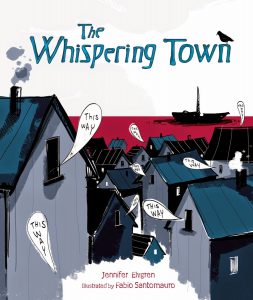 The Whispering Town
The Whispering Town
Written by Jennifer Elvgren
Illustrated by Fabio Santomauro
Kar-Ben Publishing, 2014, 32 pp.
ISBN-13: 978-1467711951
In October of 1943 in a small fishing village on the Northeast coast of Denmark, Anett’s family is hiding Danish Jews in their cellar who are on their way to safety in neutral Sweden. Anett is familiar with the routine: she knows she needs to bring them food; she knows which shopkeepers are sympathetic and will give her extra meat and eggs so her family can feed their “guests.” When Nazi soldiers threaten the safety of Anett’s new friend Carl, she devises a way to guide Carl and his mother to the harbor. As Carl and his mother walk through the town on the dark moonless night, villagers whisper directions to them from doorways and windows, guiding them to the harbor and the small boat that will take them to Sweden.
The story of Danish villagers rescuing Jews is a well-known one. Villages up and down the coast were stopping points for the 7500 Jews fleeing the country. The small port of Gilleleje, where this story takes place, was one of the major ports, and many of the village boats were pressed into service to help ferry 1700 Danish Jews across the 15-mile stretch of water from Gilleleje to safety in Sweden.
In the same way that artist Roberto Innocenti uses visual distancing techniques to create emotional distance between the child reader and his Holocaust narratives (Meyer, 2009), Italian artist Fabio Santomauro uses a graphic minimalist style to effectively communicate the danger and tension of the rescue without focusing on the visceral fear of being hunted and fearing capture. The colors are digitally rendered in a reduced darker palette, conveying the furtive nature of the actions of Anett, her parents, and the other villagers. The occasional splash of red keeps the illustrations vivid and communicates the danger of hiding Jews from the Nazis. The minimalist style also gives the illustrator the chance to add facial expressions that communicate fear and friendship without overwhelming the young reader.
What also soften the story are the sparse words; the whispering is rendered in speech bubbles. American author Jennifer Elvgren chose to tell the story from the third-person perspective of a young girl — the human connection Anett makes with Carl reflects a child’s thinking. Anett not only realizes Carl and his mother need food, but she also recognizes that Carl could use some diversion and that perhaps he might want to read some of her favorite books while he waits several days in the cellar. Touched by Anett’s empathetic connection, Carl gives her one of his most precious possessions when he leaves, a heart-shaped stone he found on his last walk on the beach with his father (who is absent from the story).
The story is amazing because it shows readers that there were countries who worked tirelessly and collectively to save their citizens from harm. The collective action of Anett, her parents, the baker, the librarian and the farmer, mirrors the collective action the Danes took in WWII. The book encourages young people to think about taking action themselves. The story is relevant today, given current world controversies surrounding opening or closing doors to refugees who are fleeing for their lives. Great books to pair with The Whispering Town include Number the Stars by Lois Lowry (1989), The Boys Who Challenged Hitler: Knud Pedersen and the Churchill Club by Phillip Hoose (2015), Shadow on the Mountain by Margi Preus (2014); The Greatest Skating Race: A World War II Story from the Netherlands by Louise Borden and Niki Daly (2004), and The Boy Who Dared by Susan Campbell Bartoletti (2008).
Jennifer Elvgren is an award-winning American author who transitioned to writing books after a successful career as a journalist and short story writer for magazines. She lives on the East Coast with her husband and children. She wanted to write a book about the Holocaust for young readers, and believes that Holocaust stories for young children should focus on the helpers (like Anett and her family).
Fabio Santomauro is an Italian illustrator living in Rome. He developed his clean graphic style studying animation for cinema. He aims for breadth in his creative expression, so he experiments with many styles he features on a blog. He is also a juggler and a musician! Interviews with author and illustrator can be found here.
Susan Corapi, Trinity International University, Deerfield, IL
WOW Review, Volume IX, Issue 1 by Worlds of Words is licensed under a Creative Commons Attribution-NonCommercial-ShareAlike 4.0 International License. Based on work at https://wowlit.org/on-line-publications/review/ix-1/
